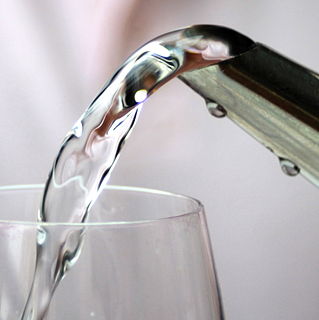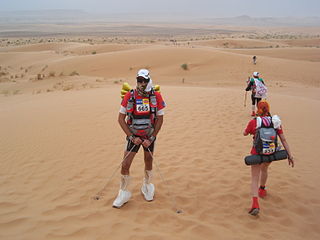Related Research Articles

The marathon is a long-distance foot race with a distance of 42.195 kilometres, usually run as a road race, but the distance can be covered on trail routes. The event was instituted in commemoration of the fabled run of the Greek soldier Pheidippides, a messenger who reported the victory by running from the Battle of Marathon to Athens. The marathon can be completed by running or with a run/walk strategy. There are also wheelchair divisions. More than 800 marathons are held throughout the world each year, with the vast majority of competitors being recreational athletes, as larger marathons can have tens of thousands of participants.
Hyponatremia is a low sodium concentration in the blood. It is generally defined as a sodium concentration of less than 135 mmol/L, with severe hyponatremia being below 120 mEq/L. Symptoms can be absent, mild or severe. Mild symptoms include a decreased ability to think, headaches, nausea, and poor balance. Severe symptoms include confusion, seizures, and coma.

Leah Sarah Betts was a young woman from Latchingdon, Essex, United Kingdom. Her death, shortly after her 18th birthday, garnered extensive media coverage.

A wine bottle is a bottle, generally a glass bottle, that is used for holding wine. Some wines are fermented in the bottle while others are bottled only after fermentation. Recently the bottle has become a standard unit of volume to describe sales in the wine industry, measuring 750 millilitres. Wine bottles are produced, however, in a variety of volumes and shapes.

Paul Kibii Tergat is a Kenyan former professional long distance runner. He became the first Kenyan man to set the world record in the marathon in 2003, with a time of 2:04:55, and is regarded as one of the most accomplished long-distance runners of all time. Runnerworld called him the "Most comprehensive runner of all time".

Trail running is a sport-activity which combines running, and, where there are steep gradients, hiking, that is run "on any unpaved surface". It is similar to both mountain and fell running. Mountain running may, however, include paved sections. Trail running normally takes place in warm climates, or on good paths, or tracks which are relatively easy to follow, and does not necessarily involve the significant amounts of ascent, or need for navigating skills, normal in fell running. Unlike road running and track running it generally takes place on hiking trails, often in mountainous terrain, where there can be much larger ascents and descents. It is difficult to definitively distinguish trail running from cross country running. In general, however, cross country is an IAAF-governed discipline that is typically raced over shorter distances.

Electrolyte imbalance, or water-electrolyte imbalance, is an abnormality in the concentration of electrolytes in the body. Electrolytes play a vital role in maintaining homeostasis in the body. They help to regulate heart and neurological function, fluid balance, oxygen delivery, acid–base balance and much more. Electrolyte imbalances can develop by consuming too little or too much electrolyte as well as excreting too little or too much electrolyte.

Water intoxication is a potentially fatal disturbance in brain functions that results when the normal balance of electrolytes in the body is pushed outside safe limits by excessive water intake.

Mauro Prosperi is a former Italian police officer and pentathlete, most notable for his nine-day disappearance in the Sahara Desert, whilst competing in the 1994 Marathon des Sables in Morocco.

Outdoor recreation, such as hiking, camping, canoeing, cycling, or skiing, entails risks, even if participants do not recklessly place themselves in harm's way. In some circumstances, such as being in remote locations or in extreme weather conditions, even a minor accident may create a dangerous situation that requires survival skills. However, with correct precautions, even fairly adventurous outdoor recreation can be enjoyable and safe.
Long slow distance (LSD) is a form of aerobic endurance training used in sports including running, rowing, skiing and cycling. Physiological adaptations to LSD training include improved cardiovascular function, improved thermoregulatory function, improved mitochondrial energy production, increased oxidative capacity of skeletal muscle, and increased utilization of fat for fuel. Ernst van Aaken, a German physician and coach, is generally recognized as the founder of the long slow distance method of endurance training.
Anne Marie Letko is an American long-distance runner who competed in the Summer Olympics in 1996 and 2000 (5000m).
The distance, in boxing, refers to the full number of rounds in a match. It is frequently used in the expression "going the distance", which means fighting a full bout without being knocked out.

The men's marathon at the 1904 Summer Olympics in St. Louis, United States, took place on August 30 of that year, over a distance of 24.85 miles (40 km).

Ronald Hill MBE was a British runner and clothing entrepreneur. He was the second man to break 2:10 in the marathon; he set world records at four other distances, but never laid claim to the marathon world record. He ran two Olympic Marathons, and achieved a personal marathon record of 2:09:28. In 1970, Hill won the 74th Boston Marathon in a course record 2:10:30. He also won gold medals for the marathon at the European Championships in 1969 and the Commonwealth Games in 1970. Hill laid claim to the longest streak of consecutive days running – every day for 52 years and 39 days from 1964 to 2017.
Jack Strangl Bacheler is an American former long-distance runner and two-time U.S. Olympian. Born in Washington, District of Columbia, Bacheler was a founding member of the Florida Track Club at Gainesville, Florida in the late 1960s, and personally designed the club's distinctive "orange" logo. Standing 6 feet 7 inches, yet weighing only 165 pounds, he towered over most of his competitors. Now living in Clayton, North Carolina, he is married to Patricia Bacheler. Bacheler has two children, daughter Teresa (Teri), and son Matthew (Matt).

The management of dehydration typically involves the use of oral rehydration solution (ORS). Standard home solutions such as salted rice water, salted yogurt drinks, vegetable and chicken soups with salt can be given. Home solutions such as water in which cereal has been cooked, unsalted soup, green coconut water, weak tea (unsweetened), and unsweetened fresh fruit juices can have from half a teaspoon to full teaspoon of salt added per liter. Clean plain water can also be one of several fluids given. There are commercial solutions such as Pedialyte, and relief agencies such as UNICEF widely distribute packets of salts and sugar. The World Health Organization (WHO) describes a homemade ORS with one liter water with one teaspoon salt and six teaspoons sugar added. The WHO; however, does not generally recommend homemade solutions as how to make them is easily forgotten. Rehydration Project recommends adding the same amount of sugar but only one-half a teaspoon of salt, stating that this more dilute approach is less risky with very little loss of effectiveness. Both agree that drinks with too much sugar or salt can make dehydration worse.
Exercise-associated hyponatremia, is a fluid-electrolyte disorder caused by a decrease in sodium levels (hyponatremia) during or up to 24 hours after prolonged physical activity. This disorder can develop when marathon runners or endurance event athletes drink more fluid, usually water or sports drinks, than their kidneys can excrete. This excess water can severely dilute the level of sodium in the blood needed for organs, especially the brain, to function properly.

The 10-mile run is a long-distance road running event over a distance of ten miles (16.1 kilometres). Also referred to as a 10-miler or 10 miles run, it is a relatively common distance in countries that use the mile as a unit of reference. It is roughly an intermediate distance between the 10K run and the half marathon (21.1 km). The level of endurance required to run the distance means it attracts more seasoned runners than shorter events do and usually requires a period of preparation for first-time attempts.
References
- ↑ Scott M. Douglas, Peter D. Pfitzinger (2001) "Advanced Marathoning", ISBN 0-7360-3431-5
- ↑ Lisa Gollin Evans (1997) "An Outdoor Family Guide to Acadia National Park", ISBN 0-89886-528-X
- ↑ Jeff Galloway (2002) Galloway's Book on Running, ISBN 0-936070-27-7, p.92
- ↑ Kemble, Jamie (June 20, 2020). "Premier League water breaks explained: Why Newcastle game will stop midway through the half". ChronicleLive .
- ↑ "Croke Park say water breaks to stay despite opposition". Independent.ie .
- ↑ Sands, Katie (August 14, 2020). "New English Premiership rugby water break rules brought in". Walesonline .